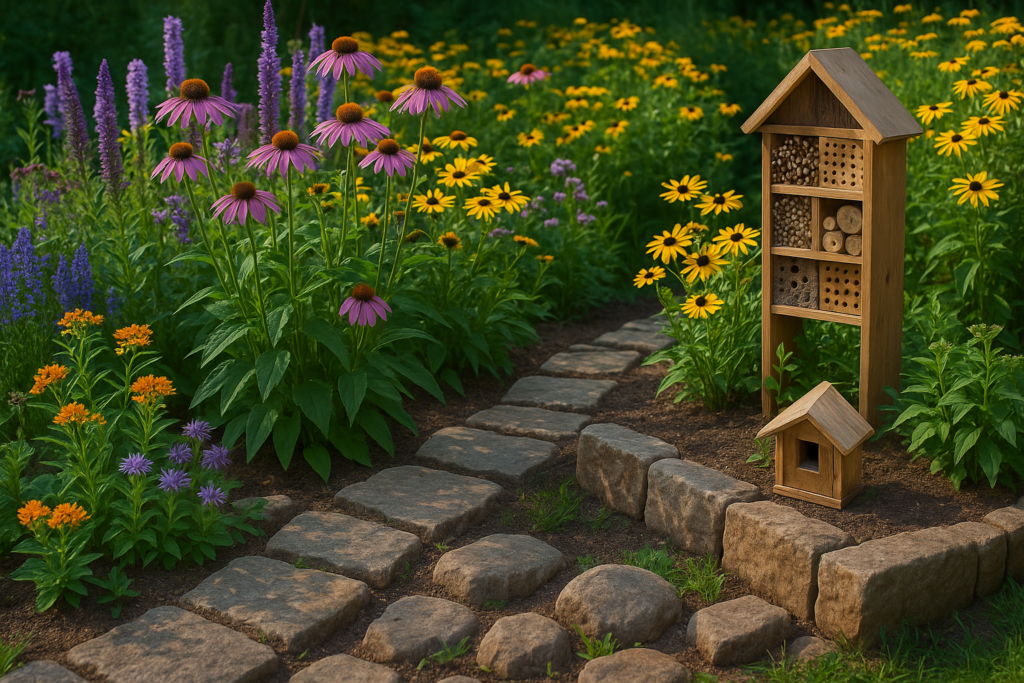Pollinator gardens are no longer just a beautiful landscaping trend—they’re an urgent environmental necessity. The decline of pollinating insects like bees, butterflies, and moths threatens biodiversity, crop production, and the health of ecosystems. Through smart garden planning, homeowners and businesses can transform their outdoor spaces into safe, nourishing havens for pollinators.
Bright View Landscape leads the way in crafting outdoor environments that balance beauty with biodiversity. By incorporating pollinator-friendly ideas, water-wise planting strategies, and sustainable soil practices, these designs go beyond aesthetics to directly support ecological health.
Why Pollinator-Friendly Landscaping Matters
Pollinators are responsible for the reproduction of over 75% of flowering plants, including a significant portion of the crops humans rely on for food. Unfortunately, habitat loss, pesticide overuse, and climate change have all contributed to alarming population declines.
Bright View Landscape embraces a design philosophy that protects and nourishes pollinators while enhancing property value and visual appeal. A well-planned pollinator garden attracts diverse species, from honeybees to hummingbirds, while offering benefits like:
- Improved soil health
- Greater biodiversity
- Reduced pesticide dependency
- Increased resilience to climate extremes
Core Elements of a Bright View Landscape Pollinator Garden
1. Use Native Plants for Maximum Impact
Native plants have evolved alongside local pollinators, making them a perfect fit for your garden’s ecosystem. They’re often more drought-tolerant, disease-resistant, and nutrient-efficient.
Incorporating natives ensures your garden thrives with minimal intervention—something Bright View Landscape emphasizes in its sustainable garden design approach. For example, milkweed for monarchs or coneflowers for bees provide both food and breeding habitats.
2. Choose Plants with Staggered Bloom Times
Pollinators need food from early spring to late fall. By designing gardens with varying bloom times, Bright View Landscape ensures that nectar and pollen are available year-round.
For example:
- Spring: Lupine, wild columbine
- Summer: Black-eyed Susan, bee balm
- Fall: Asters, goldenrod
This blooming sequence keeps pollinators coming back season after season.
3. Create Flower Shape Diversity
Different pollinators prefer different flower structures. Butterflies are drawn to tubular blossoms, while bees prefer flat or bowl-shaped flowers.
Bright View Landscape integrates a blend of shapes and sizes to attract multiple species, ensuring your garden supports a wide pollinator range.
4. Incorporate Vibrant Color Palettes
Color diversity is more than an aesthetic choice—it’s a magnet for different pollinators. Bees gravitate to blues and purples, butterflies to reds and oranges, and moths to whites and creams.
By planting in colorful drifts rather than scattered singles, Bright View Landscape creates visually striking and ecologically functional gardens.
Habitat and Care Features for Pollinators
5. Provide Safe Nesting Spaces
Many native bees nest in the ground or hollow stems. Designing open soil patches, leaving some dead wood, and adding bee hotels ensures a year-round safe haven.
6. Add Watering and Mineral Stations
Pollinators need clean, shallow water sources. A pebble-filled birdbath or mud puddling area can serve as both a hydration point and a mineral source. Bright View Landscape often integrates these features naturally within stone or kerb stone borders (kerb stone).
7. Limit Pesticide Use
Avoiding harmful chemicals is non-negotiable for pollinator health. Instead, Bright View Landscape incorporates companion planting and beneficial insect attraction to manage pests naturally.
Linking Sustainability with Functionality
Pollinator gardens can work hand-in-hand with other sustainable practices. For example:
- Soil Health: Compost integration, as outlined in Bright View Landscape With Composting Integration, boosts soil fertility and reduces the need for synthetic fertilizers.
- Water Conservation: Using drought-tolerant plants, as discussed in Bright View Landscape | Low-Water Plant Design for Sustainable Beauty, minimizes irrigation demands.
- Waste Reduction: Incorporating on-site composting, as covered in Bright View Landscape | Composting for Healthier, More Sustainable Gardens, keeps green waste out of landfills.
Functional Landscape Additions
While plants and flowers form the heart of a pollinator garden, Bright View Landscape also ensures practical features enhance usability and beauty.
- Material Transport: Landscaping often requires moving soil, compost, and plants. Using a material handling trolley makes these tasks more efficient.
- Stone and Paving: Incorporating natural stone pathways or decorative kerbs not only adds visual appeal but also serves as heat-retaining sunbathing spots for pollinators.
Design Inspiration: Pollinator Garden Layouts
When designing for pollinators, Bright View Landscape recommends:
- Grouping 3–5 of the same plant species together to make foraging easier.
- Integrating kerb stone borders to define garden beds while preventing soil erosion.
- Mixing low-growing blooms with taller perennials to create shelter and varied feeding zones.
- Leaving wild corners with native grasses and flowering shrubs for habitat diversity.
Beyond the Garden: Broader Sustainability Integration
Pollinator-friendly designs are just one part of an eco-conscious property plan. By combining pollinator gardens with composting, drought-tolerant planting, and energy-efficient building materials like those discussed in the Insulating Glass Unit Guide for Architects and Builders, homeowners and businesses can reduce environmental impact across the board.
Educational and Community Benefits
A Bright View Landscape pollinator garden isn’t just for personal enjoyment—it can be an educational tool for schools, community centers, and public spaces. These gardens:
- Demonstrate the importance of biodiversity
- Inspire sustainable landscaping practices
- Provide a living classroom for pollinator education
Conclusion: Bright View Landscape’s Role in a Pollinator-Friendly Future
By merging aesthetic appeal with ecological responsibility, Bright View Landscape creates spaces that don’t just look good—they actively sustain life. From native blooms and compost-rich soils to functional features like material handling trolleys and kerb stones, these designs embody a commitment to beauty, sustainability, and biodiversity.
If you want to create a property that supports pollinators while enhancing your outdoor space’s visual charm, start with the expert guidance and eco-conscious principles of Bright View Landscape. Explore more ideas in Bright View Landscape and Pollinator-Friendly Ideas to begin your journey toward a greener, buzzing, and more vibrant landscape.

